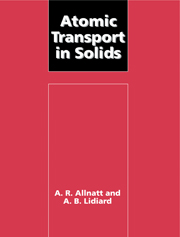Book contents
- Frontmatter
- Contents
- Preface
- List of principal symbols
- 1 Atomic movements in solids – phenomenological equations
- 2 Imperfections in solids
- 3 Statistical thermodynamics of crystals containing point defects
- 4 Non-equilibrium thermodynamics of atomic transport processes in solids
- 5 Some applications of non-equilibrium thermodynamics to solids
- 6 Microscopic theories – the master equation
- 7 Kinetic theory of relaxation processes
- 8 Kinetic theory of isothermal diffusion processes
- 9 The theory of random walks
- 10 Random-walk theories of atomic diffusion
- 11 Transport coefficients of dilute solid solutions – results and applications
- 12 The evaluation of nuclear magnetic relaxation rates
- 13 Theories of concentrated and highly defective systems
- References
- Index
5 - Some applications of non-equilibrium thermodynamics to solids
Published online by Cambridge University Press: 28 December 2009
- Frontmatter
- Contents
- Preface
- List of principal symbols
- 1 Atomic movements in solids – phenomenological equations
- 2 Imperfections in solids
- 3 Statistical thermodynamics of crystals containing point defects
- 4 Non-equilibrium thermodynamics of atomic transport processes in solids
- 5 Some applications of non-equilibrium thermodynamics to solids
- 6 Microscopic theories – the master equation
- 7 Kinetic theory of relaxation processes
- 8 Kinetic theory of isothermal diffusion processes
- 9 The theory of random walks
- 10 Random-walk theories of atomic diffusion
- 11 Transport coefficients of dilute solid solutions – results and applications
- 12 The evaluation of nuclear magnetic relaxation rates
- 13 Theories of concentrated and highly defective systems
- References
- Index
Summary
Introduction
The development in the previous chapter has necessarily been fairly abstract. In particular, although it is clear that the flux equations, when taken in conjunction with the corresponding continuity equations, in principle allow us to calculate the course of particular diffusion processes, we have not been able to give many indications of the physical characteristics of the L-coefficients appearing in these flux equations. This is, of course, to be expected at this stage since much of what follows in later chapters is about the theory of these quantities themselves. For the moment therefore they remain phenomenological coefficients, functions of thermodynamic variables (T, concentrations and stress) and governed by Onsager's theorem. It is helpful therefore at this stage to look at the relations between these L-coefficients and more familiar phenomenological coefficients adequate in special situations and which have been studied experimentally, e.g. chemical and isotopic diffusion coefficients, electrical ionic mobilities and ionic conductivity. Throughout we shall keep our assumptions about the nature of the systems being considered fairly broad. In particular, we shall not go out of our way to deal explicitly with dilute solid solutions, even though these are enormously important in fundamental studies. The more detailed results which are obtained for such systems are considered later after we have presented the atomic theory of the L-coefficients and evaluated them for particular models.
We begin by considering one of the simplest applications of the formalism, namely that to interstitial solid solutions in metals (§5.2). The simplicity of these systems allows us to describe several distinct phenomena with a minimum of mathematical manipulation.
- Type
- Chapter
- Information
- Atomic Transport in Solids , pp. 181 - 215Publisher: Cambridge University PressPrint publication year: 1993
- 1
- Cited by



